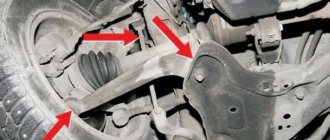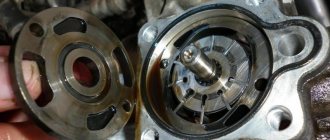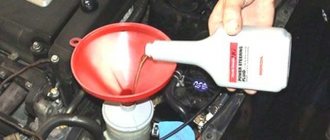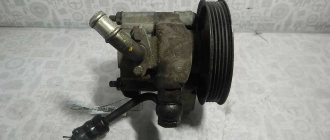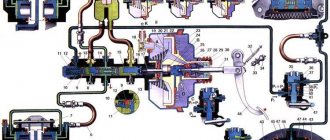Thanks to the close cooperation of the AvtoVAZ concern and Renault, car enthusiasts received a reliable and unpretentious Lada Largus car. This model has become quite popular for many reasons, including functionality, practicality, good build quality and affordable price. Due to the high ground clearance and low overhangs, excellent cross-country ability is ensured, the powerful power plant produces good dynamic characteristics, and the modern steering mechanism, complemented by hydraulic power steering, helps to steer the car with ease.
Characteristics of power steering of Lada Largus
This unit is no less important than the brake system. The safety of the driver and passengers also depends on its performance. Power steering (hydraulic power steering) provides the ability to control the car by easily positioning the drive wheels in the desired direction.
Largus power steering diagram
The Lada Largus is equipped with a combined type hydraulic booster, i.e. some of its elements are located directly in the steering mechanism housing. In other words, they are a component of the mechanical part of the steering column. Power steering Lada Largus consists of a standard set of elements:
- tank;
- power steering pump, complemented by a working fluid bypass valve;
- pipelines;
- redistribution mechanism;
- working mechanism.
There are not many components, which explains the high reliability of the hydraulic booster. Malfunctions associated with its operation occur infrequently. Typically, problems arise due to violations of operating rules by the car owners themselves. Much less often - due to the natural wear and tear of parts, but, of course, one cannot ignore the low quality of components.
Maintenance comes down to following simple rules. The main thing is to regularly check the level of working fluid in the expansion tank of the system. The power steering does not require additional adjustments.
It's easy to check; just open the hood. The fluid in the system is also needed to lubricate the power steering elements. If the level is low, parts will begin to wear out too quickly. With such use, the unit is more likely to fail.
Reviews
Grigory, Dnepropetrovsk. I drove 110 thousand km on Largus, the car is still holding up. A decent workhorse that is worth the money. This van has paid for itself a long time ago and brings in a stable profit. I give a thumbs up to comfort and multimedia options, as long as the suspension can withstand the loads being transported from point A to point B. The VAZ 1.6 engine consumes around 11 liters in the urban cycle.
Vladimir, Lipetsk region. My wife has a Logan, and I have a more practical seven-seater Largus, suitable for forays into nature over rough terrain. The main advantage of Largus compared to the previous Logan is a lot of space. And in this regard, the station wagon simply cannot have competitors for that kind of money. The unpretentious 1.6-liter engine never fails, the main thing is to fill the oil and filters on time. Average consumption 9 l.
Features of the Lada power steering device
The Largus steering mechanism is conventional, rack and pinion type. It is designed on the principle of a gear moving along a rack, but a hydraulic booster is used to ease the applied pressure on the steering wheel. A similar mechanism is common on most passenger cars. This is explained simply: the design consists of a minimum of parts, the efficiency of the power steering is high. Despite its reliability, the power steering mechanism cannot withstand constant movement over potholes and uneven road surfaces, hence the frequent occurrence of vibrations.
A pump with blades is installed on the power steering of Lada Largus, with the help of which it is possible to move oil in the power steering system. The vane pump is located on the engine, where it is mounted on a bracket and built into the timing drive, i.e. the pump blades are driven by the crankshaft drive poly-V belt. This means that you need to tighten the generator belt in a timely manner, although there is a special tensioner roller for this.
The steering mechanism drive structurally has two steering rods connected to the suspension steering knuckle arms at the front using hinge joints. Unlike other VAZ models, the Largus has a subframe on which the steering rack with power steering is mounted in the boot (on all other VAZ models the steering mechanism is mounted on the engine compartment panel).
During the startup of the power plant, the oil in the Largus power steering system moves from the tank through the pressure created by the pump to the distribution valve. When the wheel is turned in one direction or another, using this valve, one of the power steering cavities is connected to the tubes, and the other to the high pressure pipeline. The power steering piston is connected to the steering rack and drives the gear, as a result of which the rack also begins to move. The movement of the rack to the right or left causes the steering knuckles to turn, thus making a turn to the right or left.
Damage to the power steering does not particularly affect the ability to drive the car. The only drawback is the significant increase in effort when necessary to turn the steering wheel.
Problems due to low fluid level in the power steering system
There can be many power steering malfunctions on any car, since the design and operating features of the parts imply natural wear and tear. Some things are related to low fluid levels. The main sign indicating an insufficient oil level in the power steering is the need to make significant efforts when turning the steering wheel or a creaking sound when turning the steering wheel of the Lada Largus. This may also indicate a drive malfunction or contamination of the working fluid.
Also, a low fluid level can be confused with a pump malfunction. If there is not enough working fluid in the system, the pump will not be able to pump the required amount of oil into the distribution valve and the actuator will not be able to distribute the load, which will immediately affect the need to apply more force to the steering wheel when turning.
A low power steering fluid level is also accompanied by air entering the system. Air bubbles lead to a decrease in operating pressure in the power steering system. A similar problem also arises due to loss of system tightness. The problem will also be reported by the indicator on the control panel, which transmits readings from the oil level sensor to the power steering.
A decrease in oil level in the power steering system is most often a consequence of a leak. This is one of the most important power steering problems that car owners face. Most often it appears at the point where tubes are connected to parts of the system, for example, to a pump. Leakage also occurs due to damage to the tubes or loss of elasticity of the rubber sealing elements; usually such gaskets are used in all connections of the hydraulic booster system. To eliminate a leak, you must first find the location of the leak; in the case of joints, it is enough to tighten them properly. If the leak is due to damaged tubes, they should be replaced.
Things are more complicated with damaged or worn sealing elements. The main problem is the labor-intensive process, since it is necessary to remove the leaking unit and repair it with replacement of rubber sealing elements. In advanced cases, extraneous sounds occur, indicating failure of the power steering components, and a grinding noise appears when turning.
Factory oil and selection rules
Since the Lada Largus is actually an analogue of the Renault Logan, power steering oil from the French model is suitable for this car. In turn, this is confirmed by the manufacturer Largus.
What is recommended to use to replace power steering fluid on Lada Largus
| Conditions | Brand |
| Oil like the “French” Renault Logan has the best viscosity and density indicators, created taking into account operation in Russian conditions at temperatures down to minus 40 degrees, and this turns out to be quite enough for use in the middle zone. | Synthetic or semi-synthetic oil based on the D2 ATF standard, as well as PSF. |
| Pay attention to the service book. | The oil listed there is ELF RENAULTMATIC D2. |
| If the vehicle is actively used and the load on the steering mechanism is significant or the vehicle is used in areas with extremely low temperatures. | In this case, it is recommended to use oil marked D3 or Elf RENAULTMATIC G3. |
In addition to these brands of power steering fluid, the manufacturer recommends some analogues that are as close in their characteristics as possible to the original:
- Mobil ATF 220 or 320;
- Castrol ATF D2 or D3;
- Liqui Moly ATF 1100.
When changing power steering oil yourself, you should keep in mind that you should never mix fluid of different brands.
The result of such mixing will be foaming of the oil and, as a result, failure of the power steering. To replace, you must use the full volume of working fluid. Only compliance with such simple rules and recommendations for monitoring the oil level and choosing the right brand will ultimately lead to stable operation of the entire steering system as a whole. This way you can save money on expensive repairs, and also significantly reduce the risk of getting into an accident due to a faulty steering mechanism.
Replacing power steering fluid
Hello everyone!
Autumn has arrived, and while there are still warm days, the idea came up to change the oil in the power steering. After looking through the service book and not finding the replacement interval (for all 150k mileage), I decided to change it, mileage 84k. Many change to both 30 and 60-70. And the situation is depressing. I thought it would be the same for me, but it turned out to be not bad, but on the verge. There is nothing difficult about replacing, everyone wrote and said, but I also want to))) I hung up the front wheels (so that there is no load on the suspension at the time of pumping/draining). I pumped out the liquid with a syringe. I took off the clamps and pulled off the hoses.
He placed a bucket under the ends of the hoses and began to intensively turn the steering wheel from lock to lock about 10-15 times.
I washed the entire barrel of dirt, the filter mesh and the breather under the lid. There was no dirt on the mesh (there were only small crumbs).
The oil still slightly resembled red, or rather brown ((((
In the light you can see the filament through the oil.
I chose the oil that the ELF elfmatic G3 1L factory recommends
Next, I assembled it in reverse order. Don’t forget to match the hose marks with the barrel (excessive bending of the hose is possible).
I poured a full barrel, closed the lid and also performed 15 turns of the steering wheel from lock to lock. And top it up to the level. We lower the car, start it, turn the steering wheel several times, check the level again and everything is ready. It feels like the steering wheel has become a little tighter, almost imperceptibly. The old oil was thin, the new one was thicker. As many people write, a liter is not included there, about 900 ml was included when it was set to 1.2. Well, most of the oil has been replaced, which means it can already be considered more than a partial replacement))) Of all the liquids, the only thing left to change is the coolant, well, I think it will be changed closer to 100k. Respect to those who read to the end! And please advise which coolant is suitable for the k4m and how much is needed.
Source
Changing power steering oil on Lada Largus cars
Sooner or later, the system requires replacement of the working fluid, just like in the engine. According to technical regulations, power steering oil filled at the factory is designed for a mileage of no more than 40,000 kilometers or for 2 years of vehicle operation.
Replacement before due date
Changing the working fluid once every 40 thousand kilometers does not mean that you can forget about it and not periodically check its condition in the system. An unscheduled power steering oil change is required in the following cases:
- metal particles in liquid;
- darkening of oil;
- foreign odors.
The reason for replacing the fluid may also be a decrease in its level in the system due to a leak. This is due to the fact that a low oil level in the power steering system causes it to heat up excessively, and this leads to failure of the main power steering components. If the car has not been used for a long time, the oil in the power steering must be changed, since there is a high probability of condensation forming during this time, and this causes the formation of an emulsion. Accordingly, the liquid loses all its basic properties and cannot be used for its intended purpose.
Oil change instructions
Any car owner can change the working fluid in the power steering system. There is nothing complicated here, and there is no need to contact a car service. Do-it-yourself oil change work begins with preparing the following tools and materials:
- about two liters of oil recommended by the manufacturer;
- 20 cc syringe milliliters and a tip with a hose to it;
- socket wrenches;
- a suitable container for draining old oil.
Before starting the replacement procedure, the engine should be warmed up to operating temperature. Then use a syringe and a hose to pump out the liquid from the expansion tank. The further process is as follows.
- The car is installed on an overpass or above an inspection hole; if this is not possible, you can simply lift the front part with a jack.
- Remove the battery and additionally its casing.
- To get to all the necessary pipes at the steering mechanism, you need to remove all the interfering plastic parts.
- Inspect the entire power steering system, thereby identifying any leaks or cracks on the expansion tank.
- Since the liquid has been removed from the tank, it can be dismantled by removing it from its mounts.
- The tube going to the power steering on the steering mechanism is disconnected from the reservoir; be sure to close the fitting on which the tube was installed.
- Finding a drain pipe is not difficult: its size is smaller. After which it is lowered into a suitable container prepared in advance.
- Next, you will need the help of a second person. The assistant must, while in the cabin, turn the steering wheel to the right and left all the way. The waste liquid will be drained into the container. To speed up the process, you can start the propulsion system.
- When draining the fluid, you must remember not to allow air to enter the hydraulic booster system. To avoid such situations, a second person should periodically add oil to the tank. If there is no assistant, you cannot start the engine. It is enough to rotate the steering wheel in both directions until all the liquid has drained from the pipe.
After draining the old fluid, new oil is poured into the tank and the engine starts. Now you need to turn the steering wheel in both directions to the extreme positions. Periodically you need to monitor the fluid level in the tank. When decreasing, add oil and continue manipulating the steering wheel until the level in the tank stops falling and air bubbles appear. After replacement and testing, all that remains is to assemble all the plastic parts and install them in place, then once again check the tightness of the clamps on the connections.
When the power steering fluid is correctly replaced, the steering wheel rotates easily and without the need to apply force (with the engine running).
Bleeding the power steering
If the fluid replacement algorithm is not followed or for other reasons, the system may become airborne. It's very easy to check. Start the engine and turn the steering wheel in different directions several times. After this, monitor the oil level in the tank. The difference when the power unit is running and after it is stopped should be no more than 5 mm.
A stronger fluctuation in the oil level indicates the presence of air in the power steering system.
To expel it, lift the front of the car and fill the reservoir with fluid to the maximum level. Without starting the engine, turn the steering wheel several times to the right and left to the extreme positions. Start the engine and again turn the steering wheel in different directions until it stops. Set the wheels straight and turn off the engine.
Check the oil level in the tank and add it if necessary. Repeat this procedure until the liquid level in the tank stops falling.

